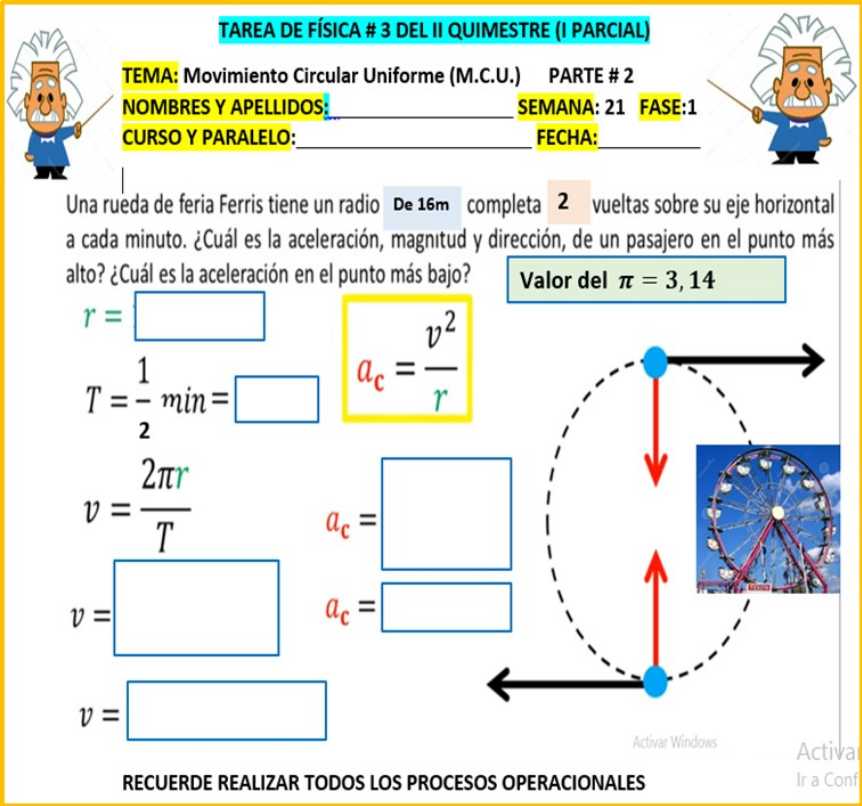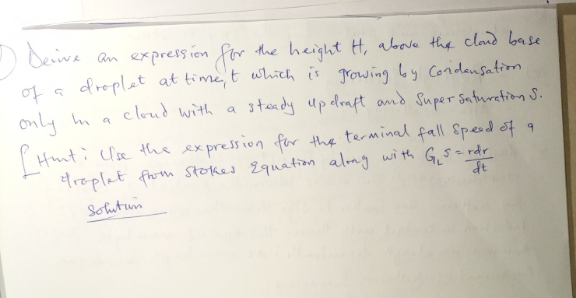
Question and Answers Forum
Moderm PhysicsQuestion and Answers: Page 1
















|
Question and Answers Forum |
Moderm PhysicsQuestion and Answers: Page 1 |

|

|
| A generation is about one-third of a lifetime.Approximately about how many generations have passed since the year 0AD? |
| A bullet with a velocity of 30 ms^(−1) after pentrating a 6 cm whole tree the velocity is reduced by one−third and then the bullet travels for 1s more. Will the bullet penetratee th tree? Analyze mathematically. |

|

|
| define microscopic and macroscopic with one one example. |

|
| Find the total energy (in Joules) of a particle of mass 4.0×10^(−11) kg moving at 80% the speed of light. |
| if here are 20 apple in a box, how many are the significant figures in it? |
| which object or substance has the 2rd number velocity after light? |

|
| Help me sir in phase sppace d^3 p=dp_x dp_(y ) dp_z then find ∫_0 ^∞ P^(2 ) e^(p^2 /(2mKT )) d^3 p =.... |

|

|

|

|

|

|

|
| A nuclide _(81)^(210) X decays to another nuclide _(80)^A Y in four successive radioactive decays. Each decay involves the emmision of either an alpha particle or a beta particle. The value of A is: A. 120 B. 206 C. 208 D. 212 |

|

|

|
| Suppose you are in a imagnary train which travels at the half of the speed of light. Suppose You have a brother who is 7 year smaller than you. He stands on the platform which you had left. After 1 hour of travelling on the train you come back on the platform. Then you observe something strange. You can see your brother looks older . So what is his age?(He was ten years old) |
| (4.1) ψ_μ (x)≡⟨x,μ∣ψ⟩ (4.2) ψ_μ (x−a)=[1−a•(∂/∂x)+(1/(2!))(a•(∂/∂x))^2 −…]ψ_μ (x) =exp(−a•(∂/∂x))ψ_μ (x)=⟨x,μ∣exp(−i((a•p)/h^ ))∣ψ⟩ (4.3) ∣ψ^′ ⟩≡U(a)∣ψ⟩ ; U(a)≡exp(−ia•p/h^ ) translation operator (4.4) ψ_μ (x−a)=⟨x,μ∣U(a)∣ψ⟩=⟨x,μ∣ψ^′ ⟩=ψ_μ ^′ (x) (4.5) ih^ ((∂∣ψ⟩)/∂a_x )=−ih^ ((∂∣ψ⟩)/∂x)=p_x ∣ψ⟩−− Passive transformations (1) ψ_μ (x;a+y)=exp(a•(∂/∂y))ψ_μ (x;y) (2) ⟨x,μ;0∣U(−a)∣ψ⟩=ψ_μ (x+a;0)=ψ_μ (x;a) (4.6) ∣x_0 ,μ⟩=∫d^3 p∣p,μ⟩⟨p,μ∣x_0 ,μ⟩=(1/h^(3/2) )∫d^3 pe^(−ix_0 •p/h^ ) ∣p,μ⟩ (4.7) U(a)∣x_0 ,μ⟩=(1/h^(3/2) )∫d^3 pe^(−ix_0 •p/h^ ) U(a)∣p,μ⟩ =(1/h^(3/2) )∫d^3 pe^(−i(x_0 +a)•p/h^ ) ∣p,μ⟩ =∣x_0 ,a⟩,μ⟩ Operators from expectation values (1) ⟨ψ∣A∣ψ⟩=⟨ψ∣B∣ψ⟩ (2) λ(⟨∅∣A∣χ⟩−⟨∅∣B∣χ⟩)=λ^∗ (⟨χ∣B∣∅⟩−⟨χ∣A∣∅⟩) (4.8) 1=⟨ψ^′ ∣ψ^′ ⟩=⟨ψ∣U^+ U∣ψ⟩ unitiry operator U^+ U=I ; U^+ =U^(−1) (4.9) U(δθ)=I−iδθτ+O(δθ)^2 (4.10) I=U^+ (δθ)U(δθ)=I+iδθ((τ^+ −τ)+O(δθ)^2 (4.11) i((∂∣ψ^′ ⟩)/∂θ)=τ∣ψ^′ ⟩ (4.12) U(θ)≡lim_(N→∞) (1−i(θ/N)τ)^N =e^(−iθτ) τ (hermition) = generator of U & the transformation (4.13) U(𝛂)=exp(−i𝛂•J) ; J_i :angular-momentum operators (4.14) i((∂∣ψ⟩)/∂α)=𝛂^ •J∣ψ⟩q (4.15) parity transformation P≡ (((−1),0,0),(0,(−1),0),(0,0,(−1)) ) ; Px=−x (4.16) quantum parity operator P: P ψ_μ ^′ (x)≡⟨x,μ∣P∣ψ⟩≡ψ_μ (Px)=ψ_μ (−x)=⟨−x,μ∣ψ⟩ (4.17) ψ_μ ^(′′) (x)=⟨x,μ∣P∣ψ^′ ⟩=⟨−x,μ∣ψ^′ ⟩ =⟨−x,μ∣P∣ψ⟩=⟨x,μ∣ψ⟩=ψ_μ (x) (4.18) ⟨∅∣P∣ψ⟩^∗ =∫d^3 xΣ_μ (⟨∅⇂x,μ⟩⟨x,μ⇂P⇂ψ⟩)^∗ =∫d^3 xΣ_μ (⟨∅⇂x,μ⟩⟨−x,μ⇂ψ⟩)^∗ =∫d^3 xΣ_μ (⟨ψ⇂−x,μ⟩⟨x,μ⇂P^2 ⇂∅⟩) =∫d^3 xΣ_μ (⟨ψ⇂−x,μ⟩⟨−x,μ⇂P⇂∅⟩)=⟨ψ∣P∣∅⟩ (4.19) Mirror operators ⟨x,y∣M∣ψ⟩=⟨y,x∣ψ⟩ (4.20) U^+ (a)xU(a)=x+a (4.21) x+δa⋍(1+i((δa•p)/h^ ))x(1−i((δa•p)/h^ )) =x−(i/h^ )[x,δa•p]+O(δa)^2 (4.22) [x_i ,p_j ]=ih^ δ_(ij) (4.23) U^+ (a)xU(a)=U^+ (a)U(a)x+U^+ (a)[x,U(a)]=x+U^+ (a)[x,U(a)] (4.24) U^+ (a)xU(a)=x−(i/h^ )U^+ (a)[x,a•p]U(a)=x+a Rotations in ordinary space R^T =R^(−1) ; det(R)=+1 ; R(𝛂)𝛂^ =𝛂^ TrR(𝛂)=1+2cos∣𝛂∣ ; v^′ =v+𝛂×v (4.25) R(𝛂)⟨ψ∣x∣ψ⟩=⟨ψ^′ ∣x∣ψ^′ ⟩=⟨ψ∣U^+ (𝛂)xU(𝛂)∣ψ⟩ (4.26) R(𝛂)x=U^+ (𝛂)xU(𝛂) (4.27) x+δ𝛂×x⋍(1+iδ𝛂•J)x(1−iδ𝛂•J) =x+i[δ𝛂•J,x]+O(δ𝛂)^2 (4.28) (δ𝛂×x)_i =Σ_(ij) ε_(ijk) δα_j x_k (4.29) Σ_(ij) ε_(ijk) δα_j x_k =iΣ_j δα_j [J_j ,x_i ] (4.30) [J_i ,x_j ]=iΣ_k ε_(ijk) x_k (4.31) [J_i ,v_j ]=iΣ_k ε_(ijk) v_k (4.32) [J_i ,p_j ]=iΣ_k ε_(ijk) p_k (4.33) [J_i ,J_j ]=iΣ_k ε_(ijk) J_k (4.34) ⟨ψ^′ ∣S∣ψ^′ ⟩=⟨ψ∣U^+ (𝛂)SU(𝛂)∣ψ⟩=⟨ψ∣S∣ψ⟩ (4.35) S⋍(1+iδ𝛂•J)S(1−iδ𝛂•J) =S+iδ𝛂•[J,S]+O(δ𝛂)^2 (4.36) [J,S]=0 (4.37) [J,J^2 ]=0 (4.38) The parity operator: x→Px=−x −⟨ψ∣x∣ψ⟩=P⟨ψ∣x∣ψ⟩=⟨ψ^′ ∣x∣ψ^′ ⟩=⟨ψ∣P^+ xP∣ψ⟩ (4.39) {x,P}≡xP+Px=0 (4.40) {v,P}≡vP+Pv=0 (4.41) v⇂𝛚^′ ⟩=v(P⇂𝛚⟩)=−Pv⇂𝛚⟩=−𝛚P⇂𝛚⟩=−𝛚⇂𝛚^′ ⟩ (4.42) −⟨±∣v∣±⟩=P⟨±∣v∣±⟩=⟨±∣P^+ vP∣±⟩=(±)^2 ⟨±∣v∣±⟩ (4.43a) ⟨x∣PV∣ψ⟩=⟨−x∣V∣ψ⟩=V(−x)⟨−x∣ψ⟩=V(x)⟨−x∣ψ⟩ (4.43b) ⟨x∣VP∣ψ⟩=V(x)⟨x∣P∣ψ⟩=V(x)⟨−x∣ψ⟩ (4.44) p^2 P=Σ_k p_k p_k P=−Σ_k p_k Pp_k =Σ_k Pp_k p_k =Pp^2 ⇒[p^2 ,P]=0 (4.45) {P,[v_i ,J_j ]}=iΣ_k ε_(ijk) {P,v_k }=0 (4.46) 0={P,[v_i ,J_j ]}=[{P,v_i },J_j ]−{[P,J_j ],v_i }=−{[P,J_j ],v_i } (4.47) [P,J_j ]=λP (4.48) ⟨ψ^′ ∣J∣ψ^′ ⟩=⟨ψ∣P^+ JP∣ψ⟩=⟨ψ∣J∣ψ⟩ (4.48) ⟨ψ∣M^+ xM∣ψ⟩=⟨ψ∣y∣ψ⟩ Mirror operators (4.50) M^+ xM=y ⇒ xM=My (4.51) ∣ψ,t⟩=e^(−iHt/h^ ) ∣ψ,0⟩ (4.52) U(t)=e^(−iHt/h^ ) time-evolution operator (4.53) U(θ)U(t)∣ψ⟩=U(t)U(θ)∣ψ⟩ (4.54a) ⟨x∣VU(𝛂)∣ψ⟩=V(x)⟨x∣U(𝛂)∣ψ⟩=V(x)⟨R(𝛂)x∣ψ⟩ (4.54b) ⟨x∣U(𝛂)V∣ψ⟩=⟨R(𝛂)x∣V∣ψ⟩=V(R(𝛂)x)⟨R(𝛂)x∣ψ⟩ (4.55) H=Σ_(i=1) ^n (p_i ^2 /(2m_i ))+Σ_(i<j) V(x_i −x_j ) (4.56) ∣ψ,t⟩=U(t)∣ψ,0⟩ (4.57) Q_t ^∼ ≡U^+ (t)QU(t) (4.58) ⟨Q⟩_t =⟨ψ,t∣Q∣ψ,t⟩=⟨ψ,0∣U^+ (t)QU(t)∣ψ,0⟩=⟨ψ,0∣Q_t ^∼ ∣ψ,0⟩ (4.59) ⟨∅,t⇂ψ,t⟩=⟨∅,0⇂ψ,0⟩ ; ∣∅,t⟩≡U(t)∣∅,0⟩ (4.60) (dQ_t ^∼ /dt)=(dU^+ /dt)QU+U^+ Q(dU/dt) (4.61) (dU/dt)=−((iH)/h^ )U⇒(dU^+ /dt)=((iH)/h^ )U^+ (4.62) ih^ (dQ_t ^∽ /dt)=−HU^+ QU+U^+ QUH=[Q_t ^∽ ,H] (4.63) exp(−i𝛂•J)≡R(𝛂) (4.64) I=R^T (𝛂)R(𝛂)=exp(−i𝛂•J)^T exp(−i𝛂•J) =exp(−i𝛂•J^T )exp(−i𝛂•J) (4.65) 0=−in•J^T exp(−iθn•J^T )exp(−iθn•J) +exp(−iθn•J^T )exp(−iθn•J)(−in•J) −in•{J^T +J} (4.66) {R^T (𝛂)R(𝛃)R(𝛂)}𝛃^′ =R^T (𝛂)R(𝛃)𝛃=R^T (𝛂)𝛃^′ (4.67) R^T (𝛂)R(𝛃)R(𝛂)=R(𝛃^′ )=R(R(−𝛂)𝛃) (4.68) (1+i𝛂•J)(1+i𝛃•J)(1−i𝛂•J)⋍1−i(𝛃−𝛂×𝛃)•J (4.69) α_i β_j [J_i ,J_j ]=iα_i β_j Σ_k ε_(ijk) J_k (4.70) [J_i ,J_j ]=iΣ_k ε_(ijk) J_k (4.71) Prob(at x⇂ψ)=Σ_μ ∣⟨x,μ⇂ψ⟩∣^2 (4.72) R(∅)= (((cos ∅),(−sin ∅),0),((sin ∅),(cos ∅),0),(0,0,1) ) (4.73) J_z ^′ =≡M•J_z •M^+ (4.74) S_x =(1/( (√2))) ((0,1,0),(1,0,1),(0,1,0) ) ; S_y =(1/( (√2))) ((0,(−i),0),(i,0,(−i)),(0,i,0) ) ; S_z = ((1,0,0),(0,0,0),(0,0,(−1)) ) (4.75) ⟨x∣p⟩=e^(ip•x/h^ ) (4.76) [{A,B},C]={A,[B,C]}+{[A,C],B} (4.77) G≡(1/2)(1−P) (4.78) S⟨ψ∣x∣ψ⟩=⟨ψ∣S^+ xS∣ψ⟩ (4.79) S_(ij) =δ_(ij) −2n_i n_j (4.80) V(x)=f(R)+λxy ; R=(√(x^2 +y^2 )) |